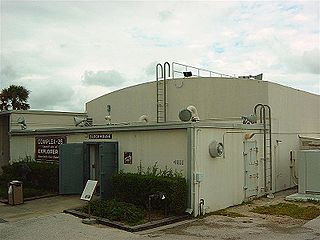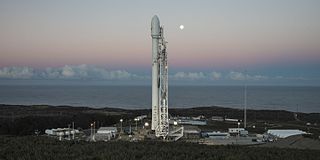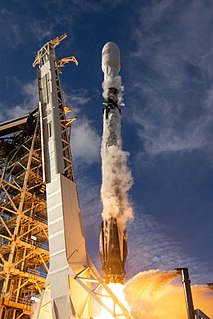
Cape Canaveral Air Force Station (CCAFS) is an installation of the United States Air Force Space Command's 45th Space Wing.

Launch Complex 39 (LC-39) is a rocket launch site at the John F. Kennedy Space Center on Merritt Island in Florida, United States. The site and its collection of facilities were originally built for the Apollo program and later modified for the Space Shuttle program.

Space Launch Complex 3 (SLC-3) is a launch site at Vandenberg Air Force Base that consists of two separate launch pads. SLC-3E (East) is currently used by the Atlas V launch vehicle, while SLC-3W (West) has been demolished.

Cape Canaveral Air Force Station Space Launch Complex 41 (SLC-41), previously Launch Complex 41 (LC-41), is an active launch site at Cape Canaveral Air Force Station. The site is currently used by United Launch Alliance (ULA) for Atlas V launches. Previously, it had been used by the USAF for Titan III and Titan IV launches. The first launch of Vulcan is currently expected in April 2021.

Launch Complex 14 (LC-14) is a launch site at Cape Canaveral Air Force Station in Florida. LC-14 was used for various manned and unmanned Atlas launches, including the Friendship 7 flight aboard which John Glenn became the first American to orbit the Earth.

Launch Complex 36 (LC-36)—formerly known as Space Launch Complex 36 (SLC-36) from 1997 to 2010—is a launch complex at Cape Canaveral Air Force Station in Brevard County, Florida. It was used for Atlas launches by NASA and the US Air Force from 1962 until 2005.

Launch Complex 26 (LC-26) is a deactivated launch site at Cape Canaveral Air Force Station, Florida. LC-26 consisted of two pads, A and B. Pad A was used for the Jupiter-C and Juno I rockets, and was the launch site for Explorer 1, the United States' first satellite, in 1958. Pad B was used for Juno II. Jupiter IRBMs were launched from both pads.

Cape Canaveral Air Force Station Space Launch Complex 40 (SLC-40), previously Launch Complex 40 (LC-40) is a launch pad for rockets located at the north end of Cape Canaveral, Florida.

Space Launch Complex 4 (SLC-4) is a launch and landing site at Vandenberg Air Force Base with two pads, both of which are used by SpaceX for Falcon 9 launch operations; operating as Landing Zone 4 (LZ-4) for SpaceX landings.

Launch Complex 11 (LC-11) at Cape Canaveral Air Force Station, Florida, is a launch complex used by Atlas missiles between 1958 and 1964. It is the southernmost of the launch pads known as Missile Row. When it was built, it, along with complexes 12, 13 and 14, featured a more robust design than many contemporary pads, due to the greater power of the Atlas compared to other rockets of the time. It was larger, and featured a concrete launch pedestal that was 6 metres (20 ft) tall and a reinforced blockhouse. The rockets were delivered to the launch pad by a ramp on the southwest side of the launch pedestal.

Launch Complex 12 (LC-12) at Cape Canaveral Air Force Station, Florida was a launch pad used by Atlas rockets and missiles between 1958 and 1967. It was the second-most southern of the pads known as Missile Row, between LC-11 to the south and LC-13 to the north. Along with Complexes 11, 13 and 14, 12 featured a more robust design than many contemporary pads, due to the greater power of the Atlas compared to other rockets of the time. It was larger, and featured a concrete launch pedestal that was 6 metres (20 ft) tall and a reinforced blockhouse. The rockets were delivered to the launch pad by means of a ramp on the southwest side of the launch pedestal.

As of December 2017, SpaceX uses three leased orbital launch sites: Launch Complex 39A of the Kennedy Space Center, Space Launch Complex 40 at Cape Canaveral Air Force Station, both in Florida, and Space Launch Complex 4E of the Vandenberg Air Force Base in California. Space Launch Complex 40 was damaged in the Amos-6 accident on September 2016 and repair work was completed by December 2017. SpaceX is also building a commercial-only launch facility at the Boca Chica site near Brownsville, Texas and is expected to be operational no earlier than 2019.

An autonomous spaceport drone ship (ASDS) is an ocean-going vessel derived from a deck barge, outfitted with station-keeping engines and a large landing platform and is controlled by an autonomous robot. Construction of such ships was commissioned by aerospace company SpaceX to allow for recovery of rocket first-stages at sea for missions which do not carry enough fuel to return to the launch site after boosting spacecraft onto an orbital trajectory.

Falcon 9 Full Thrust is a partially reusable medium-lift launch vehicle, designed and manufactured by SpaceX. Designed in 2014–2015, Falcon 9 Full Thrust began launch operations in December 2015. As of 17 December 2019 Falcon 9 Full Thrust had performed 57 launches.

Landing Zone 1 and Landing Zone 2, also known as LZ-1 and LZ-2 respectively, are landing facilities for recovering components of SpaceX's VTVL reusable launch vehicles. LZ-1 and LZ-2 were built on land leased in February 2015 from the United States Air Force, on the site of the former Cape Canaveral Air Force Station Launch Complex 13. SpaceX built Landing Zone 2 at the facility to have a second landing pad, allowing two Falcon Heavy boosters to land simultaneously.

Falcon 9 booster B1029 is a first-stage reusable rocket booster for the Falcon 9 orbital launch vehicle manufactured by SpaceX. B1029 was the second orbital-class booster in the history of rocketry to be flown again after a vertical landing. It was also the first to land without damage on an autonomous spaceport drone ship in the Pacific Ocean and to be launched from both coasts of the United States.
The private aerospace company Blue Origin has a number of development, manufacturing, and test facilities in four US states: Washington, Texas, Florida, and Alabama.

Falcon 9 booster B1047 was a reusable Falcon 9 first-stage booster manufactured by SpaceX.


















